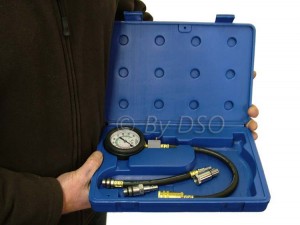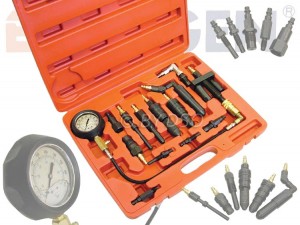 Compression is an important measure of an engine’s functioning. The engine can be seen as an air pump that is self-powered. In order to deliver the best performance, the engine needs good compression.
Compression is an important measure of an engine’s functioning. The engine can be seen as an air pump that is self-powered. In order to deliver the best performance, the engine needs good compression.
A compression tester is the tool that measures engine pressure. It provides information about faulty valves and worn pistons that could cause low compression and the poor performance of your car’s engine.
What is Compression Testing?
If you want to perform DIY compression testing, you will have to rely on a manual tester. An engine analyser is another possibility but it is common among professionals. Keep in mind that the equipment needed to examine compression in gasoline and diesel engines is different.
The test should be performed periodically or when you are experiencing some problems with the car. A loss of vehicle power is most commonly caused by low compression. The compression gauge can be used to assess the pressure that the piston exerts on the fuel inside the engine.
Compression gauges are relatively affordable. If you are serious about keeping your car in top condition, investing in a compression tester is the right thing to do.
Why is It Important to Check the Engine Compression?
Different engines require different amount of pressure to function properly. For gasoline engines, the average compression ranges between 140 and 160 pounds per square inch (psi). A compression below 85 psi is a sign of serious problem.
Very high compression is a cause of concern, as well. Too much pressure will result in issues like resignation that can damage the internal structure of the engine. As already mentioned, there is a difference between gasoline and diesel engines. Diesel engines require a much higher compression because the pressure is needed to ignite the diesel. Compression of 350 psi is normal for diesel engines.
Tips for Performing a Compression Test Accurately
To perform a compression test on your diesel vehicle, you will have to follow several steps.
Make sure that you have everything necessary. You will need a compression tester kit. The average kit contains the fittings that should be used for replacement of injectors and glow plugs.
Start the car and allow the engine to reach the normal operating temperature. Stop it and remove all of the injectors or glow plugs. You may need the manufacturer’s manual to deal with the engine, especially if you have never done it before. Be very careful about touching hot or moving engine parts.
The compression tester should be screwed into the injector or glow plug hole. Double check before moving to the next step.
Disable the fuel injection pump by disconnecting the fuel shut off valve. The throttle should be in the wide open position before you turn the engine over six to eight revolutions. As you do that, the compression tester will record the highest value reached.
 Depress the bleed valve button to release all of the engine pressure. Unscrew the compression tester and move on to the next cylinder.
Depress the bleed valve button to release all of the engine pressure. Unscrew the compression tester and move on to the next cylinder.
If the compression tester records a value below 100 psi for one of the cylinders, you may try pouring a teaspoon of oil in before retesting. A higher reading the second time will indicate a piston problem.
Doing compression testing can help you pinpoint accurately engine problems. Buy a good compression tester kit and learn how to follow the necessary steps. The test will make you a more informed owner and help you figure out what kind of repair will be needed.
Author – Tony Heywood

Tony Heywood is a ‘Retail Troubleshooter’ with 40 years experience in the retail industry, specialising in e-commerce over the last decade. He has his own consultancy firm and is MD of ’e sell it’, an on-line store selling tools and auto-care products worldwide.
For tools & auto-care products at trade prices, please visit: www.esellit.com
Or call: 020 8201 0588